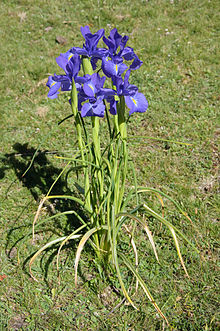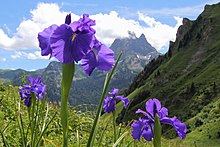
Iris is a flowering plant genus of 310 accepted species with showy flowers. As well as being the scientific name, iris is also widely used as a common name for all Iris species, as well as some belonging to other closely related genera. A common name for some species is flags, while the plants of the subgenus Scorpiris are widely known as junos, particularly in horticulture. It is a popular garden flower.

Lavandula angustifolia, formerly L. officinalis, is a flowering plant in the family Lamiaceae, native to the Mediterranean. Its common names include lavender, true lavender and English lavender ; also garden lavender, common lavender and narrow-leaved lavender.

Iris xiphium, commonly known as the Spanish iris, is an iris native to Spain and Portugal. It has also been found in Corsica, South West France, southern Italy, Algeria and Tunisia. This species is also known as the small bulbous-rooted iris or xiphium iris.

Iris subg. Scorpiris, commonly called Juno, is a subgenus of Iris, representing the smooth-bulbed bulbous irises. For a while it was an independent genus Juno Tratt. in some classifications.

Iris japonica, commonly known as fringed iris, shaga and butterfly flower, is a native of China and Japan. It is a species in the genus Iris, in the subgenus Limniris and within the Lophiris section. It is a rhizomatous perennial plant, with pale blue, lavender or white flowers with an orange or yellow crest. It is cultivated as an ornamental plant in temperate regions.
Iris pamphylica is a plant species in the genus Iris. It is the largest member of the subgenus Hermodactyloides, it is also in the section Reticulatae. It is a bulbous perennial from Antalya Province in Turkey, Asia. It has long narrow leaves, shorter stem holding a bi-coloured flower in shades of purple, blue or purple-brown, with a yellow, purple-spotted section on a petal.

Iris filifolia is a species in the genus Iris, it is also in the subgenus Xiphium. It is a bulbous perennial from North Africa and Europe. It has thin leaves, summer flowers in shades of red-purple.
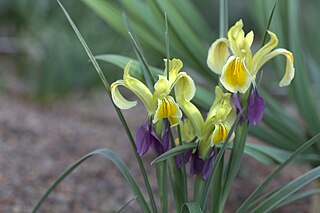
Iris fosteriana is a species in the genus Iris, subgenus Scorpiris.

Iris rosenbachiana, the spinster iris, is a species in the genus Iris, it is also in the subgenus Scorpiris. It is a bulbous perennial from Central Asia, within Tajikistan and Afghanistan. It has long mid-green leaves, short flower stem, sweet scented flowers in early spring in shades of purple.

Iris narbutii is a species of flowering plant in the genus Iris, subgenus Scorpiris. It is a bulbous perennial from Central Asia. It has dark green leaves, short stems, spring flowers in shades of greenish-yellow to pale violet.
Iris kuschakewiczii is a species in the genus Iris, subgenus Scorpiris. It is a bulbous perennial from the hills of Kazakhstan. It has dark green glaucous leaves, a short thick stem and purple spring flowers.

Iris korolkowii is a plant species in the genus Iris. It is also in the subgenus Iris and in the section Regelia. It is a rhizomatous perennial, from the mountains of Tien Shan, Pamir and Altai, in Afghanistan and Turkestan. It is commonly known as the Redvein Iris. It has long, sword-shaped grey-green leaves, slender stem, and 2 to 3 white, cream, pale green or light purple flowers which are veined with maroon, chocolate brown or dark purple. It is cultivated as an ornamental plant in temperate regions.
Iris sikkimensis is a plant species in the genus Iris, it is also in the subgenus Iris and in the section Pseudoregelia. It is a rhizomatous perennial, from Sikkim. It has pale green or light green thin leaves, slender stem, 2 or 3 lilac or purple flowers, with a white beard with orange tips. It is thought to be a hybrid of Iris hookeriana and Iris kumaonensis.
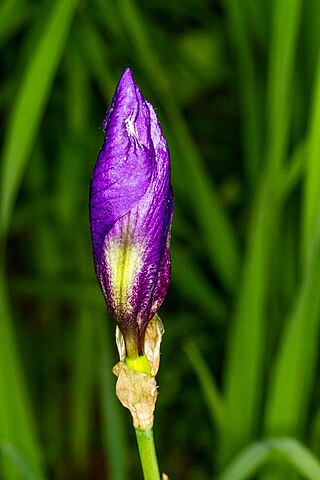
Iris sambucina, the elder scented iris, is a plant species in the genus Iris, it is also in the subgenus Iris. It is a rhizomatous perennial, from southern and central Europe. It has green, curved or sword-like leaves, tall round stem, multiple flowers in shades from brown violet, or brown-purple, to purple-violet, blue violet, mauve, and to purple. The large flowers are fragrant, with the scent of elderflowers, hence the name. It was first considered a separate species, then it was classified as a synonym of Iris germanica, before being classified as a separate species again, but with a hybrid origin from Iris pallida and Iris variegata. It is sometimes cultivated as an ornamental plant in temperate regions.

Iris acutiloba is a species in the genus Iris, it is also in the subgenus of Iris and section Oncocyclus. It is a rhizomatous perennial, from the mountains of the Caucasus and found in Turkey, Armenia, Azerbaijan, Turkmenistan, Dagestan in the North Caucasus, and Iran. It is a dwarf species, with narrow, falcate or curved leaves, it has one flower in spring or early summer, that comes in shades from cream, creamy white, whitish, pale brown, light grey, to pale violet. It is heavily veined or streaked and pointed, with 2 dark spots and brown, purple, dark purple, or black short beard. It is cultivated as an ornamental plant in temperate regions. There are two subspecies, Iris acutiloba subsp. lineolata and Iris acutiloba subsp. longitepala.

Iris atrofusca is a species in the genus Iris, where it is placed in the subgenus Iris and the section Oncocyclus. It is a rhizomatous perennial from the deserts of Israel and Jordan. The species has long falcate (sickle-shaped) or ensiform (sword-shaped) leaves, a long thick stem and large fragrant flowers that come in shades of purple brown, reddish-black, black-brown, dark brown, dark lilac or dark purple. The flowers also have a black or brownish-black signal patch and a thick beard that is brown-black, light brown or yellow tipped with brown. It is rarely cultivated as an ornamental plant in temperate regions.

Iris atropurpurea, the coastal iris is a species in the genus Iris, it is also in the subgenus of Iris and in the section Oncocyclus. It is a rhizomatous perennial, from Israel. It has glaucous (blue-green), linear, falcate (sickle-shaped) leaves. Between February and March, it has between 1 and 2 flowers, in dark shades from red-brown, burgundy, dark purple to blackish purple. They have a darker signal patch and yellow beard tipped with purple. It is rarely cultivated as an ornamental plant in temperate regions, due to it needing very dry conditions.

Iris bismarckiana, the Nazareth iris, is a species in the genus Iris, it is also in the subgenus Iris and in the section Oncocyclus. It is a rhizomatous perennial, from the mountainsides of Israel, Lebanon, Jordan and Syria. It has stoloniferous, spreading rhizomes, long, sword shaped, bright green leaves, long slender stem and 1 flower in Spring. The large flower is pale yellow, creamy-white, or white background. Which is covered with reddish-brown, maroon brown, purple-brown, purple, blue-purple, or blue veins, markings or spots. It has a dark signal patch and dark purple to black beard. It is rarely cultivated as an ornamental plant in temperate regions, as it needs very dry conditions during the summer.
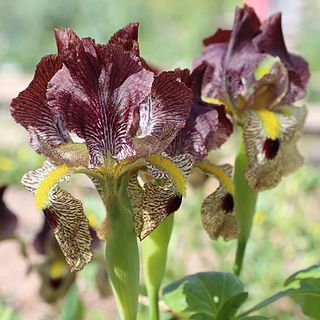
Iris paradoxa is a species of flowering plant native to western Asia. It has large upright petals and smaller lower petals, which is unique amongst most iris forms. They come in various shades from white, lavender, mauve, medium purple, violet, dark purple to black. It has a black or purplish black beard on the lower petals. It comes from the region of Transcaucasia, and is found in the countries of Iran, Turkey, Armenia and in Azerbaijan.
Iris kirkwoodiae is a plant species in the genus Iris, it is also in the subgenus Iris and in the section Oncocyclus. It is a rhizomatous perennial, from Syria and Turkey. It has white or pale greenish flowers, heavily covered with dark purple veins or dots, deep purple round signal and a beard of long brown/purple hairs. It is cultivated as an ornamental plant in temperate regions.
